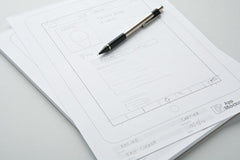App Sketchpads

App Mockup Tools has been putting the finishing touches on our
App Sketchpads.
The overall color density has been toned down. This leads to a less
distracting working environment. Also there is a light dot grid pattern
to help your lines stay straight. Its all lighter that a number 2 pencil
drawing to keep your designs prominent. Common iOS screen marking are
included to mark Status Bar, Navigation Bar, Keyboard, Tab Bar and
Toolbar.
iOS GUI Element Kits

Design and development has begun on the
iOS GUI Element Kits.
Initially there will be both 'Classic' and 'Wireframe' kits for iPhone
and iPad. The 'Classic' kit is filled with completely editable GUI
Elements that are commonly seen in iPhone iOS and in third party apps.
i.e buttons, sliders, dials,
keyboards, background, bars, etc. The 'Wireframe' Kit has 'wireframe'
elements when you don't want design to get in the way. Nearly every
element in all kits are completely editable in color, size, shadowing,
type, line width, etc.
App Prototypes can quickly be created with
interactive, click-able links to their respective screens. All done
with easy to use software you most likely already own and use. Not far
after the release of 'Classic' and 'Wireframe' Kits, 'Custom' Kits will
be announced.
Thanks for so much feedback!

